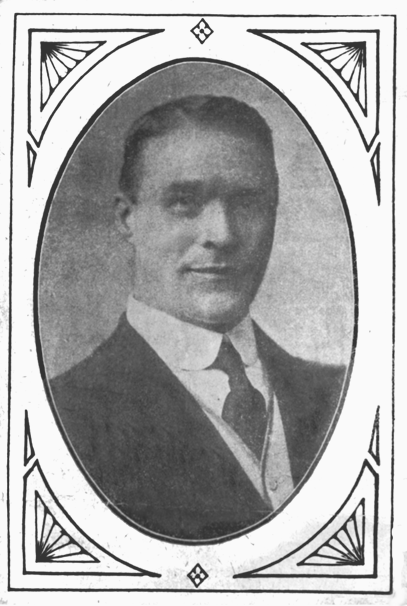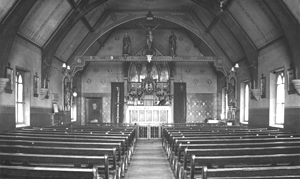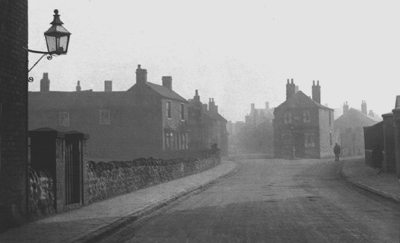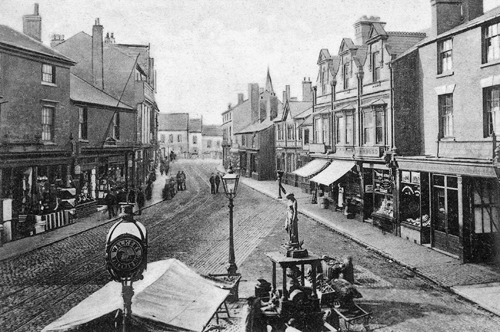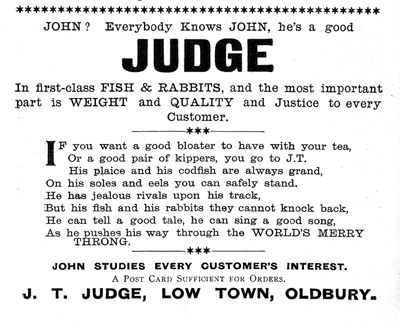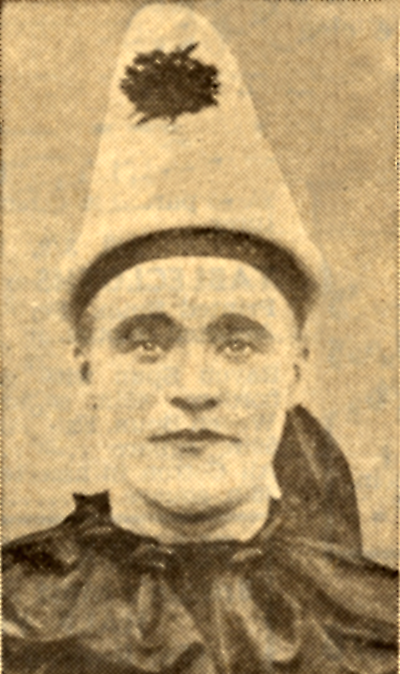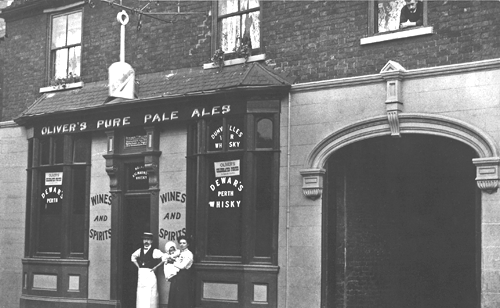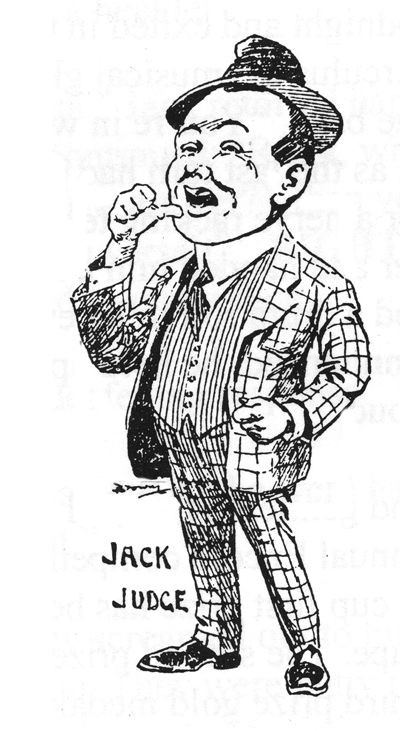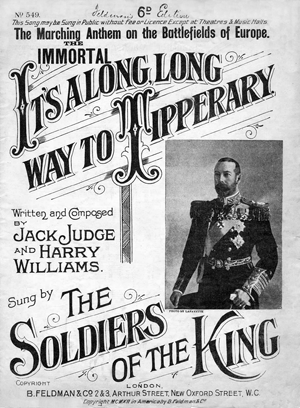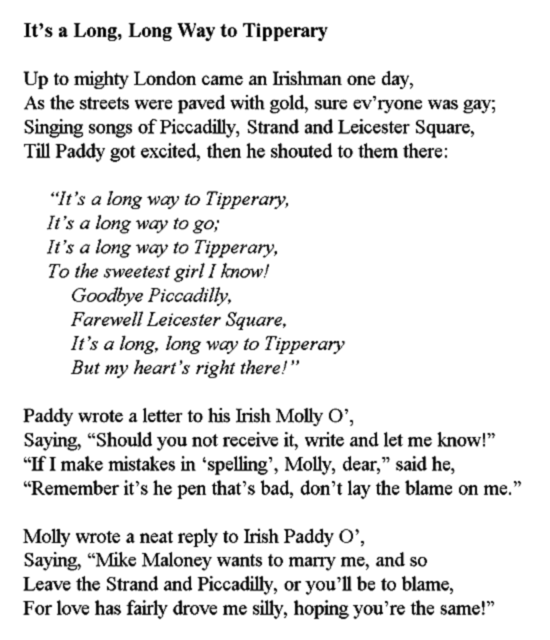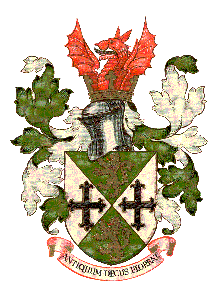
|
History
of Oldbury, Langley and Warley
|
||
|
Communities
of the West Midlands
|
||
|
The
website of Langley Local History Society - Oldbury Local History
Group - Old Warley Local History Society
|
||
 |
||
| HOME | |
| NEWS & EVENTS | |
| HISTORY SOCIETIES | |
| PUBLICATIONS | |
| GALLERY | |
| QUESTIONS | |
|
article 008 - Part 1 JACK JUDGE - HIS LIFE AND MUSIC
|
|
PART
ONE - HIS EARLY LIFE
|
||||||||||||||||||||||||||||
|
Jack Judge 1872 - 1938
John Thomas Judge was born at Oldbury in the West Midlands in 1872, and given the usual family nickname of 'Jack'. He came from humble beginnings in the Irish community of the town, working at an iron foundry, taking over the family fish business, writing songs and verses, becoming a popular music-hall entertainer for a decade in his forties, and achieving lasting recognition for wriring "Its a long, long way to Tipperary", which became one of the best-loved marching songs of the first world war. He was a big man, an irrepressible character with a great sense of humour, and generous to those in need, but also a man who saw much sadness and misfortune in his life. His early life was much like that of most other Oldbury men born at that time, a struggle to earn sufficient money to keep him and his family. What set him apart was his talent as an entertainer, and he was well-known locally long before the unexpected wartime success of 'Tipperary' made his name known across the world. His success brought controversy over whether he really wrote 'Tipperary', but the evidence, a hundred years on, suggests that he did. There are many stories associated with him: everyone over eighty in Oldbury seems to have a 'true' one, and each is slightly different! This article tries to set out the well-established facts and events of his life, and dispel some of the myths.
Arrivals and struggles Since the late 1840s, when the potato famine struck in Ireland, there had been a sizeable Irish community in Oldbury, with over 500 people on the 1851 census, amounting to about 4% of the population. The Judges, however, did not come to the Midlands until around 1860, when Rodger Judge left Carrow Beg, County Mayo, in west of Ireland and settled at Greets Green, West Bromwich. Ten years later, he was joined by his elder brother John, who brought with him his two sons John, aged 22, and James, 17.
Thomas and Jane McGuire had arrived in Oldbury from Ireland in the early 1850s, and their eldest child, Mary, was born here in 1853. She married John Judge Jnr at St Francis Xavier Catholic Church, Pinfold Street, Oldbury, in 1871. They moved into Low Town, near to the Malt Shovel public house, with the Mary's family, and so started the association of the Judge family with Oldbury. Four years later, John's brother, James, married Mary's younger sister, Ann. John and Mary Judge had their first child, John Thomas, on 3rd December 1872, and he was given the nickname 'Jack', as were all 'John's in the Judge family. Jack soon had two sisters, Jane Ann (1874) and Mary (1875). However, there was almost no Jack Judge story to tell, since, at the age of four, he fell into the canal that ran behind the houses of Low Town, and had to the rescued by an older child. .
Jack's father was an unskilled labourer, who sought work where he could find it. He was laid off by Bromford Iron Works in 1877. In the search for employment, the family left Oldbury, moving first to Wolverhampton, and later to Moseley in Birmingham, so most of Jack's education took place at St Patrick's School, Wolverhampton, and St Anne's School, Moseley. They returned to Oldbury when Bromford Iron Works were taking on labour again in 1883. Jack was not quite twelve years old, but big enough to pass for an older lad, and, bluffing his way in, both he and his father were taken on. After a couple of years, his father left the iron works, borrowed some money and set himself up as a fish dealer in 1885. He sold from a stall in front of the 'Wrexham', the common name for the Junction Vaults, opposite Christchurch, and next to 'Polly on the fountain', the drinking fountain that had been erected in 1882. This avoided paying the tolls at the official market.
Family By 1888, the John and Mary Judge had eight children, including Edward, who had been informally 'adopted'. That year, the family were struck a bitter blow, when John Judge became ill with tuberculosis, which was rife in the poor houses of Oldbury. He died in June that year, aged only 38, and to keep his fish business going, the whole family had to become involved. Mary and her daughters fetched the fish, the children helped to prepare it, and Mary sold it. Jack was still at the iron works, and Jane Ann, Jack's eldest sister, was working as a brickmaker. In the evenings, Jack and Jane Ann would take shellfish around the pubs and music halls of Oldbury. Jack soon decided to expand the business, so he bought an old, hand-cart and fetched the fish from Birmingham market, before starting his job at the iron works. To add to their burdens, in 1889, Mary 'adopted' another child, Annie. Further misfortune befell the family in 1891 when the three younger children all caught measles. Margaret, ('Maggie'), was dangerously ill, but just survived. Edward and Annie were not so strong, and both were dead by October. Hardships and difficulties of this nature were not unusual for the poor of Oldbury who had few safeguards in employment, housing or health. At this time, the loss of the breadwinner meant that many families faced a constant struggle to stay out of the workhouse at West Bromwich. The Judge family were particularly inventive and hard working, but those first years after John's death must have been a very difficult time for them. There was some improvement when Mary Judge married again in 1893. Her second husband was William Henry Withey, 'Bill', who had been born in Clifton, Bristol in 1854. He married Sarah Pow in 1879, and moved to Chorlton, near Manchester, where they had two children, William Henry and Frederick George. After Sarah died in 1891, Bill and the boys moved to Oldbury, and there he met Mary Judge. Around the time of their marriage, Mary 'adopted' Edward Withey, who was usually known as Ted Judge. Who he was remains a mystery, for no registration of a birth under either name has been traced, and his death was registered as that of 'Edward Withey'. Ted Judge, like his 'brother' Jack, became an entertainer: he worked closely with Jack and performed many of his songs.
The family was now complete, since Mary and Bill had no more children. Jack's sister Ellen, 'Nellie, who was in service at Dudley, died of tuberculosis in 1897. Bill Withey died in 1908, leaving Mary a widow for the second time. Jack was about to start his own family: in 1895, his eye was caught by Jane Ann Carroll, known as 'Jinny', who was the laundress for the Judge family. She was a quiet, petite, blue-eyed girl from the Irish community in Oldbury, quite a contrast to the big, red-haired, extrovert Jack. In June 1895, they were married at St Francis Xavier Church. They had four children, John ('Jackie') in 1897, Jane Anne ('Cissie') in 1900, Thomas in 1902, and James Patrick ('Jimmy') in 1905. Jinny was soon drawn into selling the fish, and Jack gave up his job at the iron works as soon as he could to concentrate on developing the fish business. In a strange reflection of his own childhood, in 1904, he dived into the canal to rescue two children after their pram had toppled in. He was awarded the Royal Humane Society's certificate for his bravery.
Talent In the late 1800s, the main organised entertainment in Oldbury was the music hall, the 'Gaiety' at the top of Birmingham Street opposite the Bulls Head, and the 'Old White Swan Museum and Concert Hall' in Church Street, next to the Big House. The latter was known locally as the 'Bird Show' because of the array of stuffed birds, animals and curiosities that adorned its wall. It also had a mechanical organ, and staged concerts and talent shows. Additional entertainment came from concerts and musical events staged at churches and clubs. Jack and his sister, Jane Ann, went to evening events at the music hall in the 1880s to provide a diversion from their busy days. Soon they started to enter the talent competitions, either as a duo or as soloists, and began to win prizes. Jack learned how to deal with hecklers, and the audiences began to appreciate his jokes and humorous verses, his songs and his whistling. He began to enjoy his time on stage and the applause he received. Although only in his mid teens, he was tall, big-framed, and, with his red hair, he must have had quite a stage presence.
After his father's death, Jack had less time for performance, but continued to develop his stage skills when he could. By the late 1890s, he was becoming well known locally, and he gradually got engagements in music halls further away from Oldbury. He began to dream of a semi-professional career, but the family circumstances and the fish business would not allow him to take the risk. Jack continued to write songs for his act, but was at the great disadvantage that he could not read music, so he could not write them down. He would try out new songs by singing them to the family, and tapping out the rhythm on a table top, but he had to rely on others to write out his music. Around 1903, the Malt Shovel at 21 Low Town was taken over by Benjamin Williams, and his brother, Henry, 'Harry', lived there also. Harry was disabled and used a wheelchair, but was a very good piano player. Jack, who lived next door at number 19, used the Malt Shovel as his local, and he and Harry became friends. Harry wrote down some of the songs that Jack composed at this time, and may well have arranged and harmonised them as well.
Apart from music, they also shared an interest in gambling, and Jack was soon in debt to Harry. Harry also lent Jack money from time to time. Jack was not good at holding on to money: he liked a drink and a smoke, as well as a bet, but he was always generous to those in need, and many of his appearances were free, for charities. Despite his income from his music, he was never well off, and never owned a house. As a result of Harry's help, Jack made him a promise that, if he ever got a song published, he would add Harry's name to it.
Between 1900 and 1910, Jack was building up his repertoire and gaining experience. His act consisted of jokes, songs, whistling, and much interaction with the audience, either to put down hecklers or to encourage the audience to join in the choruses. He had a stock of songs in draft at home, which he used in his concert and music hall performances. He was greatly appreciated by the Oldbury Volunteers [1st Volunteer Battalion, 'K' Company], and accompanied them on their annual camps, helping to provide entertainment for the company. Doubtless, Jack tried out all his new material on them.
His great breakthrough came in 1910, when he entered a variety competition organised by the stage magazine 'Encore' in London. He performed one of his most popular songs, 'How are Yer?' in a bright check suit with a striped waistcoat. The audience was not very friendly to the artists, but Jack won them over and got them joining in the chorus. Jack only came third in the competition, but took much of the publicity in the reviews, and suddenly he was wanted at music halls and theatres throughout the country. The professional stage was open to him. As there were more hands to help with the fish business, he was able to go on a tour of the country, taking his stock of songs from the previous decade with him, and polishing them up for his act. He had free time between the performances, and would usually find a suitable public house to while away the hours. One of his favourite tricks in a bar was to steer the conversation around to his song-writing, and get someone to challenge him towrite a new song over-night for a bet, knowing that there were still unused songs in his old stock!
'Tipperary' In January 1912 Jack was performing at the Grand Theatre, Stalybridge, just east of Manchester. In the Newmarket Inn, Jack ran the 'song overnight trick', and performed his 'new' song on 31st January, and won his bet for five shillings. It was called 'It's a long way to Tipperary', and it was well received by the audience at the Grand. There is significant doubt over just how 'new' the song really was. Many Oldbury people claim to have heard the song before this date: some say that it was written at the Malt Shovel; some of Jack's family claim that he tried it over at his sister Jane Ann's house at Brades Village, Oldbury; there are claims that it was first sung by a ten-year-old Oldbury girl, Alice Franklyn, who performed as 'Baby Franklyn', after Jack showed it to her. There are claims that the inspiration for 'Tipperary' was the phrase 'It's a long way to ...', which was overheard by Jack at Stalybridge, or at Oldbury, or at Smethwick, or several other places. There are even claims that it was sung to the Oldbury Volunteers, or the Oldbury Territorials who replaced them, at their annual camps. Given all this evidence, it is likely that a version of 'Tipperary' existed in some form before its composition at Stalybridge. It may even have been thedraft of a song, 'It's a long way to Connemara'. Jack probably used this as a basis for 'It's a long way to Tipperary' which was, indeed, first written in its final form at Stalybridge. Jack, himself, in a newspaper interview in 1933, said that he wrote it at Stalybridge in response to a bet, but he did not comment on its inspiration. A hundred years on, we cannot be certain of the origin of the song.
Following the success at Stalybridge, Jack advertised 'Tipperary' for sale in the stage press. It was noticed by the music publisher and impresario Bert Feldman in London, who was interested in the song for Florrie Forde, a leading music hall artiste of the day. Feldmann, Jack and Florrie Forde met at London, and Bert Feldman agreed to publish two of Jack's songs, 'Its a long way to Tipperary' and 'Mona from Barcelona'. He did insist on one change to 'Tipperary', the inclusion of a second 'long' in the chorus and the title, so it became 'It's a long, long way to Tipperary'. A royalty agreement was signed by Jack and Bert Feldman on 18th September 1912. Jack remembered his promise to Harry Williams and included Harry's name as co-author of both songs. Florrie Forde took the song into her act in 1913, and it was well received. The sheet music sold steadily, and Bert Feldman published more of Jack's songs as a result, six in 1913, including 'The Way the Wind Blows', and eleven in 1914. All of these had the name of Harry Williams as co-author. John McCormack made the first recording of 'Tipperary' in 1914. Jack sang 'Tipperary' all round the country to enthusiastic audiences. One of the places where it was well received was Dublin, where it was heard by a contingent of the Irish Connaught Rangers. It touched a chord with them, and they must have gone away singing the song. This was critical for the fame of 'Tipperary'.
Sources The information in this article has been taken from 'Jack Judge, the Tipperary Man' by Verna Hale Gibbons, from articles by Leslie Frost in the Oldbury Weekly News in 1962, from contemporary newspaper articles, from Gillian Nicklin (Jack's only great-granddaughter), from research and family papers of the Stanley family (descendants of Jack's sister, Jane Ann), and from personal research. Dates of births, marriages and deaths have been taken from these sources and the birth, marriage and death indices available online at freebmd.rootsweb.com, and from the on-line databases of ancestry.co.uk and familysearch.org.
Text and family tree in this format: © Dr Terry Daniels, 2011 Pictures and illustrations: © Various, as stated in captions Contact for permission to reproduce
If you have objects, photographs, records or other items associated with Jack Judge, please contact this website, since the local history societies of Oldbury are building up as complete an archive on Jack Judge as possible, and would like to add copies of anyitems to it. We are particularly interested in copyinging recordings of Jack's music.
|
